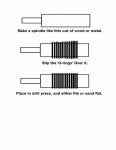Ok, so it is time to buy some new tires for my MTH engines. I thought I'd stock up on the three sizes that would cover all my MTH locomotives. So I went on the MTh website, looked at the chart, and put the appropriate tires in my cart. THEN I SAW THE PRICE!!!!!!
A dollar each for tires? Are they out of their frickin' minds..... (that's a rhetorical question).
I'm not especially cheap. I will pay a thousand dollars for the right engine, I understand the technology and detail that goes into modern locomotives. But I would feel like a fool paying a dollar each for rubber bands. They have been around forever and there is no "technology" involved. They should be a dollar a dozen!!
So I'm conducting an experiment. After searching several threads regarding tire substitutes, I purchased several types of silicone sealants, some Plastidip and some JB Weld. (I skipped on the Bullfrog snot).
The JB Weld is my own idea. Might be stupid, but who knows?
I put the sealant on several locomotives and the Permatex water pump sealant seemed to work the best, of the sealants, that is. Eventually, after around thirty hours of run time, pulling a heavy load, it did begin to show some wear. But no wheel slip, even then.
I applied the JB Weld differently than instructed in the tire threads. (Just don't clean the grooves with alcohol, use acetone or detergent instead) I put it on the same way, with the locomotive (Lionel F3) upside down and running slowly. But I applied just a little more than necessary. I let it cure two days and ran the engine, upside down, using sandpaper wrapped around a square dowel to "sand" off the excess. Just to where the JB Weld filled the groove.
I really loaded up that F3's consist. I've run it constantly at various speeds for almost a week now and that JB Weld is working great. Best of everything I tried. Even immune to smoke fluid.
Now, I know filling the driver wheel grooves with JB Weld isn't for everyone. It probably won't help the resale value of the locomotive, but that's a problem for the kids when my estate sale comes up sometime in the "distant" future
Right now I'm thinking of just using it on the couple of engines that throw tires occasionally, and I don't see why locomotives can't come from the factory with a more high tech solution to old fashioned tires, which have been around for generations. There are all kinds of high tech composites out there. I'm sure one can be found that would work better than what we now have.
Then it might be worth paying a dollar each for them.
A dollar each for tires? Are they out of their frickin' minds..... (that's a rhetorical question).
I'm not especially cheap. I will pay a thousand dollars for the right engine, I understand the technology and detail that goes into modern locomotives. But I would feel like a fool paying a dollar each for rubber bands. They have been around forever and there is no "technology" involved. They should be a dollar a dozen!!
So I'm conducting an experiment. After searching several threads regarding tire substitutes, I purchased several types of silicone sealants, some Plastidip and some JB Weld. (I skipped on the Bullfrog snot).
The JB Weld is my own idea. Might be stupid, but who knows?
I put the sealant on several locomotives and the Permatex water pump sealant seemed to work the best, of the sealants, that is. Eventually, after around thirty hours of run time, pulling a heavy load, it did begin to show some wear. But no wheel slip, even then.
I applied the JB Weld differently than instructed in the tire threads. (Just don't clean the grooves with alcohol, use acetone or detergent instead) I put it on the same way, with the locomotive (Lionel F3) upside down and running slowly. But I applied just a little more than necessary. I let it cure two days and ran the engine, upside down, using sandpaper wrapped around a square dowel to "sand" off the excess. Just to where the JB Weld filled the groove.
I really loaded up that F3's consist. I've run it constantly at various speeds for almost a week now and that JB Weld is working great. Best of everything I tried. Even immune to smoke fluid.
Now, I know filling the driver wheel grooves with JB Weld isn't for everyone. It probably won't help the resale value of the locomotive, but that's a problem for the kids when my estate sale comes up sometime in the "distant" future
Right now I'm thinking of just using it on the couple of engines that throw tires occasionally, and I don't see why locomotives can't come from the factory with a more high tech solution to old fashioned tires, which have been around for generations. There are all kinds of high tech composites out there. I'm sure one can be found that would work better than what we now have.
Then it might be worth paying a dollar each for them.





